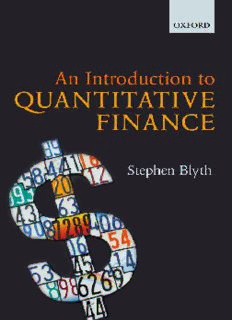Table Of ContentAn Introduction to Quantitative Finance
STEPHEN BLYTH
ProfessorofthePracticeofStatistics,HarvardUniversity
ManagingDirector,HarvardManagementCompany
3
3
GreatClarendonStreet,Oxford,OX26DP,
UnitedKingdom
OxfordUniversityPressisadepartmentoftheUniversityofOxford.
ItfurtherstheUniversity’sobjectiveofexcellenceinresearch,scholarship,
andeducationbypublishingworldwide.Oxfordisaregisteredtrademarkof
OxfordUniversityPressintheUKandincertainothercountries
©StephenBlyth2014
Themoralrightsoftheauthorhavebeenasserted
FirstEditionpublishedin2014
Impression:1
Allrightsreserved.Nopartofthispublicationmaybereproduced,storedin
aretrievalsystem,ortransmitted,inanyformorbyanymeans,withoutthe
priorpermissioninwritingofOxfordUniversityPress,orasexpresslypermitted
bylaw,bylicenceorundertermsagreedwiththeappropriatereprographics
rightsorganization.Enquiriesconcerningreproductionoutsidethescopeofthe
aboveshouldbesenttotheRightsDepartment,OxfordUniversityPress,atthe
addressabove
Youmustnotcirculatethisworkinanyotherform
andyoumustimposethissameconditiononanyacquirer
PublishedintheUnitedStatesofAmericabyOxfordUniversityPress
198MadisonAvenue,NewYork,NY10016,UnitedStatesofAmerica
BritishLibraryCataloguinginPublicationData
Dataavailable
LibraryofCongressControlNumber:2013941968
ISBN978–0–19–966658–4(hbk.)
ISBN978–0–19–966659–1(pbk.)
Printedandboundby
CPIGroup(UK)Ltd,Croydon,CR04YY
ForAthena,SophiaandAnita
This page intentionally left blank
PREFACE
ThisbookisbasedonAppliedQuantitativeFinanceonWallStreet,anupperlevelunder-
graduatestatisticscoursethatIhavetaughtforseveralyearsatHarvardUniversity.The
studentstakingtheclassaretypicallyundergraduateconcentratorsinmathematics,applied
mathematics,statistics,physics,economicsandcomputerscience;master’sstudentsinstat-
istics;orPhDstudentsinquantitativedisciplines.Nopriorexposuretofinanceorfinancial
terminologyisassumed.
Many students who are considering a career in finance study this material to gain an
insightintothemachineryoffinancialengineering.However,someofmystudentshave
nointerestinafinancialcareer,butsimplyenjoyprobabilityandaremotivatedtoexplore
oneofitscompellingapplicationsandinvestigateanewwayofthinkingaboutuncertainty.
Othersmaybecuriousaboutquantitativefinanceduetotheregulatoryandpolicy-making
attentiontheindustryhasreceivedsincethefinancialcrisis.
Thebookconcernsfinancialderivatives,aderivativebeingacontractortrade(orbet,
depending on your prejudices) between two entities or counterparties whose value is a
function of—derives from—the price of an underlying financial asset. We define vari-
ous derivative contracts and describe the quantitative and probabilistic tools that were
developedtoaddressissuesencounteredbypractitionersasmarketsdeveloped.Thebook
issteepedinpractice,asthemethodsweexploreonlydevelopedtosuchanextentbecause
themarketsthemselvesgrewexponentiallyfast.Whilstwedeveloptheoryhere,thisbookis
nottheoreticalinthe‘existingonlyintheory’sense.Theproductsweconsideraretradedin
significantsizeandhavemeaningfuleconomicimpact.
Probability provides the key tools for analysing and valuing derivatives. The price of
a stock or a bond at some future time is a random variable. The payout of a derivative
contractisafunctionofarandomvariable,andthusitselfanotherrandomvariable.We
showthatthepriceoneshouldpayforaderivativeiscloselylinkedtotheexpectedvalue
ofitspayout,andthatsuitablyscaledderivativepricesaremartingales,whicharefunda-
mentallyimportantobjectsinprobabilitytheory.Thebookfocuseslargelyoninterestrate
derivatives—wheretheunderlyingfinancialvariableisaninterestrate—forthreereasons.
First,theyconstitutebyfarthelargestandmosteconomicallyimportantderivativemar-
ketintheworld.Secondly,theyaretypicallythemostchallengingmathematically.Thirdly,
theyhavegenerallybeenlesswelladdressedbyfinancetextbooks.
Backgroundandmotivation
The structure and content of the book are shaped by the experiences of my career in
bothacademiaandonWallStreet.IreadmathematicsasanundergraduateatCambridge
UniversitywhereIwasfortunatetobetaughtprobabilitybybothFrankKellyandDavid
vi | preface
Williams.IobtainedaPhDinStatisticsatHarvardUniversitywithKjellDoksumbefore
teaching for two years at Imperial College London, where I lectured the introductory
probabilitycourseformathematicsundergraduates.
MymovetoWallStreetwascatalysedindirectlybyPresidentClinton’sdecisiontocan-
celthesuperconductingsupercolliderin1993.TwoHarvardhousemates,boththeoretical
physicists,sawtheacademicjobmarketforphysicistscollapseovernightandbothquickly
foundemploymentatGoldmanSachsinNewYork.Theirassertionthatderivativemar-
kets(whateverinfacttheywere)were‘prettyinteresting’andmathematicallychallenging
convincedmetocontemplateamovefrommynascentacademiccareer.
IstartedatHSBCinLondon,hireddirectlybyaCambridgePhDmathematician.On
myfirstdayatworkIwastaskedtocalculatetheexpectedvalueofafunctionofbivariate
normalrandomvariables.ImovedsubsequentlytoMorganStanleyinNewYorkwhereI
becamemanagingdirectorandthemarketmakerforUSinterestrateoptions.Throughout
mystintatMorganStanleyIworkedwithanotherCambridgemathematician.Together
wedevelopedatrainingprogramfornewanalysts,motivatedbymathematicalandprob-
abilisticchallengesandsubtletiesweencounteredintherapidlydevelopinginterestrate
optionsmarketsofthelate1990s.Severaloftheproblemsfromthatmini-coursehavefound
their way into this book. Indeed much of the theory I develop is motivated by a desire
toprovideasuitablyrigorousyetaccessiblefoundationtotackleproblemsIencountered
whilst trading derivatives. This fundamental motivation led me to create the course at
Harvardandsubsequentlydevelopthisbook,whichIbelievecombinesanunusualblendof
derivativestradingexperienceandrigorousacademicbackground.
AfteraspellinLondonrunninganinterestrateproprietarytradinggroupatDeutsche
Bank, I rejoined Harvard in 2006 where I currently wear two hats: head of public mar-
ketsattheHarvardManagementCompany,thesubsidiaryoftheuniversityresponsiblefor
managingtheendowment;andProfessorofthePracticeofstatisticsatHarvardUniversity,
whereIteachthecourse.MyroleattheendowmentincludesresponsibilityforHarvard’s
investment activities across public bond, equity and commodity markets. This ongoing
presenceattheheartoffinancialmarkets—Icontinuetotradeeachdayderivativecontracts
explainedinthetext—meansthatthecourse,andthusIhopethebook,retainsimmediacy
toitsfield.Inparticular,thefinancialcrisisof2008–2009challengedmanybasicfound-
ationalassumptionsbothacademicsandpractitionershadtakenforgrantedandIdetail
severaloftheseintheexposition,somesurprisinglyearly.
The Harvard statistician Arthur Dempster made the distinction between ‘procedural’
statistics,involvingtheroteapplicationofproceduresandmethods,and‘logicist’statist-
icsinwhichreasoningabouttheproblemathand—usingsubject-matterknowledgeand
judgmentinadditiontoquantitativeexpertise—playsacentralrole.Thisbookiswrittenin
thelogicisttradition,interweavingexperienceandjudgmentfromtherealworldoffinance
withthedevelopmentofappropriatequantitativetechniques.
Itisoftennotobvioustoanoutsiderwhichissuesareparticularlyimportanttotraders
andinvestorsintheWallStreetderivativemarkets.Whilsteverythinginthisbookistosome
extentmotivatedbythepracticalworld,wehighlightareaswherethedegreeofmarketrel-
evanceisnotimmediatelyapparent.Wealsoincludemarketanecdotesandtalesfromthe
Streettoprovideinsightsandrichnessintothematerial.
preface | vii
ThisbookhasbeenmotivatedbyanddistilledfrommyexperienceonWallStreet,and
alsobymyloveforprobability.Inadditiontowantingtounderstandelementsofquant-
itativefinanceinpractice,studentsmaywishtoreadthebooksimplybecausetheyhave
enjoyedtheirintroductiontoprobabilityandhaveadesiretoseehowitcanbeapplied.
Whilst there are many ways to approach financial mathematics, I find the probabilistic
routebothappealingandfulfilling.Therearehighlyintuitiveelementstothetheory,for
examplepricesbeingexpectedvalues.Furthermore,weintroduceinastraightforwardman-
ner powerful concepts such as numeraires and martingales that drive much of modern
theory, and discover that there are subtleties in various unexpected places that demand
preciseandnon-trivialunderstanding.
Prerequisites
Thesoleprerequisiteformasteringthematerialinthisbookisasolidintroductoryunder-
graduatecourseinprobability(representedbyStatistics110atHarvard,PartIAProbability
atCambridgeUniversity,orProbability&StatisticsIatImperialCollege).Familiarityis
requiredwith:discreteandcontinuousrandomvariablesanddistributions;expectation,in
particularexpectationofafunctionofarandomvariable;conditionalexpectation;thebino-
mialandnormaldistributions;andanelementaryversionofthecentrallimittheorem.The
single-variablecalculustypicallyassociatedwithsuchacourse—integrationbyparts,chain
rulefordifferentiationandelementaryTaylorseries—isusedatseveralpoints.Exercisesat
theendofthisprefacegiveasenseoftheprobabilityprerequisite.
Thebookisotherwiseself-containedandinparticularrequiresnoadditionalpreparation
orexposuretofinance.Thenecessaryfinancialterminologyisintroducedandexplainedas
required.Itellmystudentsthattheedificeofquantitativefinancewaslargelybuiltbypion-
eersfromacademicphysicsormathematicswhoenteredWallStreetwithnoknowledgeof
financeandhavingreadnofinancebooks,andwhostillhavenot.
Thisisnotabookoneconomics.Therearemanyexcellenteconomicstextsoncapital
markets,corporatefinance,portfoliotheoryandrelatedmatters,whichcomplementthis
material.However,derivativemarketsareaworldlargelypopulatedbytradersandmath-
ematicians,noteconomists.Noristhisabookontimeseriesmethodsorprediction.Aswe
seeearlyon,derivativepricing—eventhatconcerningthepriceofaforwardcontractwhich
isanexchangeofanassetinthefuture—islargelyunrelatedtoprediction.
The mathematical prerequisite is modest and no more extensive than that for an
introductoryundergraduateprobabilitycourse,althoughadeptnessatlogicalquantitative
reasoningisimportant.Whilstwebuildanappropriatelyrigorousbaseforourresults,this
isnotatheoreticalmathematicsbook.Bydevelopingmostofourtheoryusingdiscrete-time
methods, we can address important issues in finance without exposure to stochastic
processes,Itocalculus,partialdifferentialequations,MonteCarloorothernumericalmeth-
ods,allofwhichplayimportantrolesincontinuous-timefinancialmathematics.Weraise
signpoststoareasoffurtherstudyintheroughguidetocontinuoustimethatconcludesthe
book.
viii | preface
IhavenecessarilyhadtoberuthlesswithmaterialIhaveexcludedinordertokeepthe
bookappropriatetoaone-semestercourseofapproximately33lecturehours.Thebook
isselectiveratherthanencyclopaedicandmovesatalivelypace.Thisenablesstudentsto
beexposedtopowerfultheoryandsubstantiveproblemsinonesemester.Throughoutthe
bookIraisesignpoststomoreadvancedtopicsandtodifferentapproachestothematerial
which naturally arise from the exposition. Even an encyclopaedic tome cannot cover all
dimensionsofderivativemarketsandassociatedtheory.
Outline
The book is organized in five parts. The first, short part contains some preliminaries
regardinginterestratesandzerocouponbonds,andaverybriefsketchofassets.
ThebulkofthematerialiscontainedinPartsII-IV.InPartII,wedefineandexplore
basicderivativeproductsincludingforwards,swapsandoptions.Ourfirstderivative—the
forwardcontract—isintroducedandweconsidermethodsforvaluationandpricingwhich
wediscoverdonotdependonanyprobabilisticmodelling.Recentviolationsoftraditional
assumptions during the financial crisis are soon encountered. We introduce elementary
interestratederivatives,suchasforwardrateagreements(FRAs)andswaps,anddefine
futures,thefirstcontractwhosepricedependsondistributionalassumptionsoftheunderly-
ingasset.Westateformallytheno-arbitrageprinciple,afoundationofquantitativefinance,
which makes precise the arguments to which we have already appealed. Recent empir-
ical challenges to the principle of no-arbitrage manifested during the financial crisis are
discussed.Wethenintroduceanddefinecallandputoptions,keybuildingblocksofmod-
ernderivativemarkets.Weinvestigateoptionpropertiesandestablishmodel-independent
bounds on their price. We also review options on forwards, an area that can still cause
puzzlementonWallStreet.
Part III focuses on the key pricing arguments of replication and risk-neutrality. We
formalizeargumentsregardingreplicationandhedgingonabinomialtree,anddefinerisk-
neutral valuation in this setting. We show that prices are appropriately scaled expected
values under the risk-neutral probability distribution, a result which leads to the funda-
mentaltheoremofassetpricingforthebinomialtree,themostpowerfulresultofthebook.
Introducinginanaturalmannertheconceptsofnumeraireandmartingale,wegiveageneral
formofthefundamentaltheorem,whichstatesthatno-arbitrageisequivalenttotheratios
ofpricestoanumerairebeingmartingales.Bridginginasimplemannertocontinuoustime,
wetakelimitsusingthecentrallimittheoremandmovetoacontinuouscasewhereexpect-
ationunderalognormaldensityimmediatelygivestheBlack–Scholesformula.Wereview
itspropertiesandintroducetheconceptsofdeltaandvega.Thekeydualitybetweenoption
pricesandprobabilitydistributionsisthenexploredinseveralways.
PartIVdevelopstheunderstandingofinterestrateoptions,thelargest,mostimportant
andmostmathematicallychallengingofoptionsmarkets.Nobookcoversthematerialpar-
ticularlywellandthefabricofthesemarketsistypicallyonlyseenclearlybyitspractitioners.
Weintroduceandvalueinterestratecaps,floorsandswaptions,usinganelegantchoiceof
numeraire.WethendefineBermudanswaptionsandderivearbitrageboundsfortheirvalue,
preface | ix
andconstructtradesusingcancellableswaps.Twofurthertopicsininterestrateoptionsare
discussed:libor-in-arrearsandgeneralconvexitycorrections,inparticularthedetailsofone
ofthegreattradesinderivativeshistory;andabriefdescriptionoftheBGMmodelandits
volatilitysurfaces,whichunderliesmuchofcurrentinterestratemodelling.
IntheconcludingPartV,weprovideabriefintroductorysketchofthecontinuous-time
analogueofthetheorydevelopedinthebook,andraisesignpoststothepartialdifferential
equationapproachtomathematicalfinance.
Thebookincludessubstantivehomeworkproblemsineachchapter(otherthanPartV)
whichillustrateandbuildonthematerial.Theaimistomakethebookfulfilling,challenging
andentertaining,andtoconveytheimmediacyandpracticalcontextofthematerialwe
cover.
....................................................................................................................
exercises
Thefollowingexercisesprovideanindicationofthelevelofprobabilityproficiencythatis
requiredtomasterthematerialinthisbook.
1. Thenormaldistributionandexpectation
LetX ∼N(μ,ψ2)andKbeaconstant.Calculate
(a) E(I{X >K})whereIistheindicatorfunction.
(b) E(max{K–X,0}).
Hint Use(K–X)=(K–μ)–(X–μ).
(c) E(etX).
Leaveanswerswhereappropriateintermsofthenormalcumulativedistributionfunc-
tion(cid:3)(·).
Note Inthelanguageofderivatives(a)isessentiallythepriceofadigitalcalloption
and(b)isthepriceofaputoption.WeencountertheseinChapter7.
2. Thelognormaldistribution
ArandomvariableY issaidtobelognormallydistributedwithparametersμandσ if
logY ∼N(μ,σ2).WesometimeswriteY ∼lognormal(μ,σ2).
(a) UsingyouranswertoQuestion1(c),calculateE(Y)andVar(Y).
(b) Supposeμ=log f – 1σ2foraconstantf >0.CalculateE(Y)andshowthat
2
Var(Y)=f2σ2(1+ σ2 + σ4 + higherorderterms).
2 6
Description:The worlds of Wall Street and The City have always held a certain allure, but in recent years have left an indelible mark on the wider public consciousness and there has been a need to become more financially literate. The quantitative nature of complex financial transactions makes them a fascinatin

